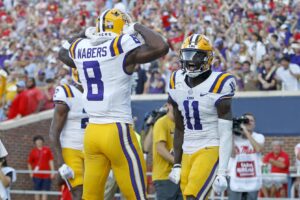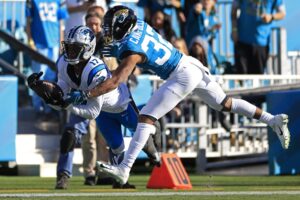Alliteration aside, every year fantasy football players become infatuated with the idea of the rookie running back. And every year there are questions about where to rank them. Well, fret not, fantasy enthusiast. The rankings below incorporate a variety of information into the rationale.
First, yards created makes the list for the majority of the ranked players. In case you’re curious, yards created charts the yards a running back creates for himself outside of blocking. A higher number suggests a more elusive ability.
Second, you will find projected wins listed for each relevant team. While projected wins will likely change as more bets are placed in Vegas, these win totals can be meaningful for fantasy production. Last year, only three running backs from a sub .500 team finished in the top 15 in scoring (half point per reception). And only seven running backs from a sub .500 team finished in top 24 in the same scoring. In short, being on a winning team matters.
Third, the draft pick invested for each running back is listed. Simply put, the draft capital invested matters. Since 2010, there have been six running backs drafted in the top 10 picks. Out of those six players, only C.J. Spiller failed to finish in top 12 in scoring (half point per reception). All in all, the higher the draft capital invested, the more opportunity for volume. And volume matters when it comes to fantasy football. Alright, without further ado, here are those rankings.
(Projected win and strength of schedule data is from Sharp Football Stats. Graham Barfield’s yards created information is from Fantasy Guru. And the statistical information can be found at PlayerProfiler)
Rookie Running Back Rankings for Redraft
Tier One
Saquon Barkley
Yards created: 6.04 per attempt (first in this class)
Projected wins: 6.6
Draft pick: 2
2017 New York Giants run blocking efficiency: 108.6 (4th)
2018 Strength of Schedule: 28th
Where you should rank him: Saquon Barkley belongs in the second tier of running backs with Leonard Fournette, Kareem Hunt, Alvin Kamara, Melvin Gordon, and Dalvin Cook. Personal preferences will shuffle the order, but Barkley’s ability should make him a part of the “who should be the fifth running back off the board” discussion this off-season.
You may have heard this before, but Saquon Barkley is good at this whole football thing. In his time at Penn State, Barkley totaled 3,843 rushing yards and 1,195 receiving yards. He also is a physical freak, with a SPARQ-x score falling in the 99th percentile. There should be no questions about his athleticism. What people may question, however, is his potential impact in his rookie season. While the strength of schedule doesn’t look too appealing, Barkley does have a few things working in his favor: his receiving ability, the additions of Nate Solder and Will Hernandez to the offensive line, and his draft capital.
Tier Two
Sony Michel
Yards created: 5.23 per attempt (in shotgun), 5.27 per attempt (under center)
Projected wins: 11.5
Draft pick: 31
2017 New England Patriots run blocking efficiency: 53.1 (25th)
2018 Strength of Schedule: 2nd
Where you should rank him: Sony Michel falls in the same tier as Kenyan Drake, Derrick Henry, Alex Collins, and other rookies. In other words, Michel lands in the mid to late RB2 tier.
Sony Michel doesn’t come without risk. His rate of fumbling the ball once every 54.6 touches aren’t exactly what normal people would call good. While that rate is a cause for concern, his fumbling rate improved last season. The other main issue is that Michel is heading into an already crowded backfield. Rex Burkhead, James White, Mike Gillislee, and Jeremy Hill are currently on the roster. The upside here is that Dion Lewis was able to produce last season with roughly 39% of the backfield work. All Michel has to do is simply reproduce what Lewis did last season. Easy, right? At least Michel’s yards created data indicates that he can be elusive. And the Patriots offense created 102 red zone rushing attempts last season (most in the NFL). There should be no reason that Michel doesn’t grab a slice of the future red zone carries.
Rashaad Penny
Yards created: 5.31 per attempt (stacked boxes), 5.79 (neutral boxes)
Projected wins: 8.2
Draft pick: 28
2017 Seattle Seahawks run blocking efficiency: 43.6 (31st)
2018 Strength of Schedule: 30th
Where you should rank him: Rashaad Penny belongs in the same tier with Sony Michel.
This is going to be a running theme, but Penny comes with risk. The most obvious one being the Seahawks offensive line. While the team found good value in Jamarco Jones in the fifth round and signed D.J. Fluker in the off-season, the offensive line should relatively be the same. The Seahawks, as a team, are also trending in the wrong direction. As of right now, Vegas projects them to win 8.2 games, which will likely lead to more negative game scripts. The good news is that Pete Carroll referred to Penny as a three-down back; although, the often injured C.J. Prosise is the more talented receiver. Penny also had a prodigious senior year–rushing for 2,248 yards–which pairs well with the Seahawks off-season theme of getting back to the running game.
Derrius Guice
Yards created: 5.88 per attempt (stacked boxes)
Projected wins: 6.9
Draft pick: 59
2017 Washington Redskins run blocking efficiency: 72.1 (15th)
2018 Strength of Schedule: 28th
Where you should rank him: In non-PPR leagues, Derrius Guice belongs in the same tier as Rashaad Penny and Sony Michel. In PPR leagues, his two down role pushes him down to the bottom of the tier.
The Redskins likely feel fortunate to have Guice last until their second pick. The former LSU Tiger rushed for over 3,000 yards in his college career and is a violent runner, who doesn’t fumble the ball as much as Samaje Perine. Translation: Guice should have no problem beating out the likes of Perine and Robert Kelley. The downside is that even when Guice wins the job, he will be limited to a two-down role. Chris Thompson is one of the best third-down backs in the league, and so Guice’s role will be limited as long as Thompson is healthy. This limitation could be problematic if the Redskins strength of schedule and projected wins come true.
Royce Freeman
Yards created: 45th percentile (in between the tackles), 42nd percentile (outside the tackles)
Projected wins: 7
Draft pick: 71
2017 Denver Broncos run blocking efficiency: 69.1 (16th)
2018 Strength of Schedule: 20th
Where you should rank him: Much like Guice, Royce Freeman‘s value will depend on the format. He loses value in PPR leagues because Devontae Booker will likely be the third-down back. However, Freeman’s talent and team fit are enough reason to put him in the same tier as Guice.
Despite not having a great yards created profile, Freeman has impressive college stats with 5,621 rushing and 814 receiving yards. However, the question now is can he continue that level of success with the Broncos? At a quick glance, the landing spot looks like a good one. The defense still has some solid players, which should help to keep Freeman relevant in games, and there is a clear path for the starting role. The downside is that while John Elway did say that Freeman can catch the ball out of the backfield, Booker and De’Angelo Henderson‘s presence will limit third-down opportunities for Freeman.
Ronald Jones II
Yards created: 3.68 per attempt (in shotgun), 3.27 per attempt (10 and 11 personnel)
Projected wins: 6.5
Draft pick: 38
2017 Tampa Bay Buccaneers run blocking efficiency: 48.5 (27th)
2018 Strength of Schedule: 31st
Where you should rank him: Ronald Jones II belongs in a tier with the likes of Jay Ajayi, Lamar Miller, Dion Lewis, and Marlon Mack. In other words, Jones is a timeshare back who falls in the late RB2-RB3 range.
There is little doubt that Jones has homerun hitting ability. Also, he landed in a great spot with a number of viable fantasy options that demand defensive attention. However, there are a number of concerns. First, his yards created profile raises questions about his elusiveness. Second, his combined 39 receptions from college and high school point towards an uncertain future for his receiving ability. And third, Rick Stroud, of the Tampa Bay Times, quoted Dirk Koetter as saying that Jones “…was an explosive guy who would be a nice complement to Peyton, a complement to the guys we got.” In other words, Peyton Barber isn’t going away yet, folks.
Nick Chubb
Yards created: 5.81 per attempt (in shotgun), 5.26 per attempt (10 and 11 personnel)
Projected wins: 5.7
Draft pick: 35
2017 Cleveland Browns run blocking efficiency: 78.8 (12th)
2018 Strength of Schedule: 25th
Where you should rank him: As of right now, Nick Chubb belongs in the same tier as Ronald Jones.
If it weren’t for Carlos Hyde, Chubb would be ranked right next to Guice. However, Hyde’s cap hit ($3.16 million for 2018) and Chubb’s draft capital (35th pick) seem to be telling two different stories. On one hand, the Browns used a high pick on Chubb, which indicates that they plan to use him quite a bit this season. On the other, Hyde’s contract seems to indicate the same. However, the Browns past shows that they don’t always play the more expensive player. When the season starts, the best the fantasy community can hope for here is a Dalvin Cook – Latavius Murray situation. And if that happens, Chubb has the athleticism and ability to make a Cook like jump in his first year.
Tier Three
Kerryon Johnson
Projected wins: 7.6
Draft pick: 43
2017 Detroit Lions run blocking efficiency: 47.6 (29th)
2018 Strength of Schedule: 26th
Where you should rank him: Kerryon Johnson falls in the same tier as Duke Johnson, Rex Burkhead, Tarik Cohen, and Theo Riddick. In other words, Johnson belongs in the RB4 tier.
Typically, the fantasy community should be more bullish on a second-round pick at running back. However, Johnson finds himself in a touch squeeze. In the Detriot backfield, Riddick already has the receiving role carved out, and it would be a surprise if LeGarrette Blount wasn’t the short yard/goal line back. As a result, Riddick and Blount limit Johnson and his path to delicious fantasy points.
Tier Four
Nyheim Hines
Projected wins: 6.3
Draft pick: 104
2017 Indianapolis Colts run blocking efficiency: 68.2 (17th)
2018 Strength of Schedule: 11th
Where you should rank him: We are venturing closer and closer towards “flyer” territory. Nyheim Hines falls in the same tier with Giovani Bernard, Corey Clement, and other satellite backs.
Hines will be a part of a committee of running backs for the Colts. Frank Reich and company will likely feature Hines’s receiving ability and his impressive speed. If the Colts feel like being creative, they could also use Hines as a slot receiver. Which is significant because the Colts are lacking receiving weapons outside of T.Y. Hilton and Jack Doyle.
Honorable Mention
In redraft leagues, a number of rookies will (and should) go undrafted. In deeper leagues, there are a few names that fall into the flyer category. Kalen Ballage doesn’t have a direct path to the starting job, but his athletic profile is intriguing. Jordan Wilkins could play a role in the committee in Indianapolis, which means there is a chance he surpasses Mack in that committee. Justin Jackson has a chance of passing Austin Ekeler on the depth chart and subsequently eating into Gordon’s reception totals.
Main photo:
Embed from Getty Images






